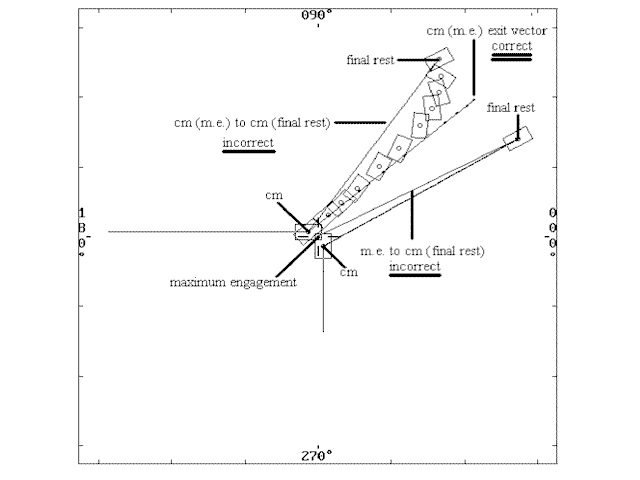
R
E C - T E C
ACCIDENT .
. . . . RECONSTRUCTION
. . . . . .
SOFTWARE
"when performance counts"
MEASURING LINEAR MOMENTUM ANGLES
Copyright Ó George M. Bonnett, J.D. 1997 All rights reserved.
Linear momentum angles have long been a thorn in the side of almost everyone attempting to investigate vehicular accidents. This single issue has probably accounted for more discussion than any other facet of linear momentum as related to accident reconstruction.
Approach angles are sometimes elusive, but there is little discussion about how the angle is obtained. The approach angle is the angle traveled by the center of mass of the respective vehicle at first contact. We may differ about the value of this angle, but all agree on what angle is being discussed and how to obtain it.
Why is this so? Is this the correct angle that should be used?
More on the approach angles later. It is the departure angles that present the real problems. How should they be measured?
One approach is measuring the angle from the center point of maximum engagement to the center of mass of the vehicle at the position of final rest. While incorrect, this is a commonly used approach by those unfamiliar with the laws of physics in general, and linear momentum in particular. This method has two errors as will be discussed later.
Another approach is to measure from the center of mass of the vehicle at maximum engagement to the center of mass at final rest. This method is also flawed as will be demonstrated.
How then should the angle be measured? Before answering that question let's define some terms.
Point mass physics is used in accident reconstruction to describe the motion of vehicles. The point used is the center of gravity (center of mass). If this point is used to measure the motion of the vehicle, it is apparent that the departure angle cannot be measured from the center point of maximum engagement. Measurement of the vector direction must be from the center of mass of the vehicle immediately after maximum engagement.
With this as our starting point, what is used as the second point in determining the line that will represent the vector direction? The vehicle comes to a stop at a given point. Why not use this point? Is it the point that should be used?
The fallacy of using final rest as the second point can be attacked using several different arguments:
Post impact distance is used with the coefficient of friction between the objects to determine the post impact velocity. This is the velocity immediately after impact. The corresponding direction, or angle, is the direction just after impact (maximum engagement). This is the angle associated with the departure velocity.
The linear momentum formula does not call for the average velocity between maximum engagement and final rest, it uses an instantaneous post impact velocity. The angle required is the vector angle associated with this instantaneous post impact velocity vector. It would be just as inaccurate to use the average direction after impact as to use the average velocity. Using the final rest methodology would be analogous to using the direction from the starting point of any motion (parking place) to the point of first contact for the approach angle. It is easy to see the possibilities of inaccuracy using this method for the determination of the approach angles. The same is true for the departure angles.
In some cases the departure angles may be the same if measured just after impact or if measured to final rest. It is also possible that the approach angle measured from the start of the trip to first contact may be the same as the instantaneous angle at first contact, but this is not always true. They can be, and often are, different.
Approach angles have there own idiosyncrasies. What should be done about the slip angle or difference between the heading of the vehicle and the direction traveled by the center of mass? The answer is nothing. Linear momentum does not utilize slip angle. The approach angle is the instantaneous angle, at first contact, traveled by the center of mass of the respective vehicle. This is the vector direction of the center of mass at first contact.
CONCLUSION: The correct approach angle is the path taken by the center of mass of the vehicle in question at first contact. The correct departure angle is the path taken by the center of mass of the vehicle in question immediately after separating from the collision (maximum engagement), not to the final rest position. While it is often difficult to measure these angles, these are the ones required by the formula to meet the requirements for the use of Linear Momentum. Using any other angles can produce inaccurate results. These inaccuracies can be due to laziness, ignorance, stupidity (practiced ignorance), or even a deliberate attempt to deceive.

Figure 1:
This figure shows a collision diagram in which one of the vehicles
spun out after impact. If the departure angle were measured to final rest, it would
vary significantly from the actual departure vector, which shows the correct
angle for a zero restitution collision. The
correct departure angle for the other vehicle just happens to be the same as the
line from the center of mass at separation to the center of mass at final rest
since the vehicle traveled in a perfectly straight line.
If restitution is involved, maximum engagement will not coincide with the
point of separation. The departure
angle at the instant of separation must be used for Linear Momentum.
1-321-639-7783
321-639-7783
Voice or Fax
Copyright Ó George M. Bonnett, J.D. 1997 All rights reserved.
Voice or Fax 1-321-639-7783
REC-TEC LLC P.O. BOX 561031 ROCKLEDGE, FL 32956 USA
Copyright © George M. Bonnett, JD
Last edited on Monday, 17 January 2022 08:39:45 PM -0500